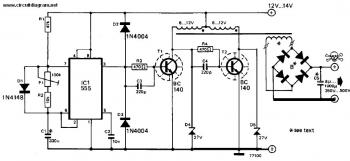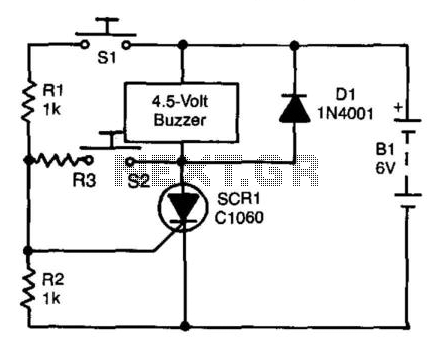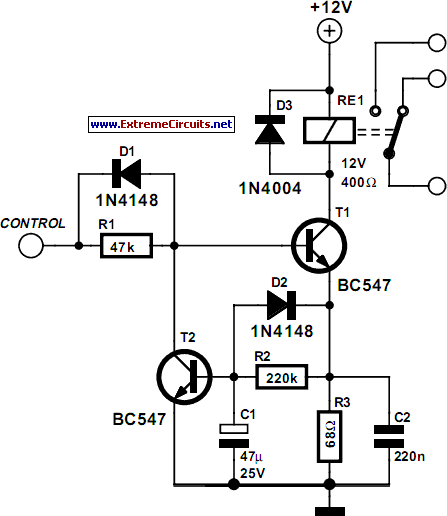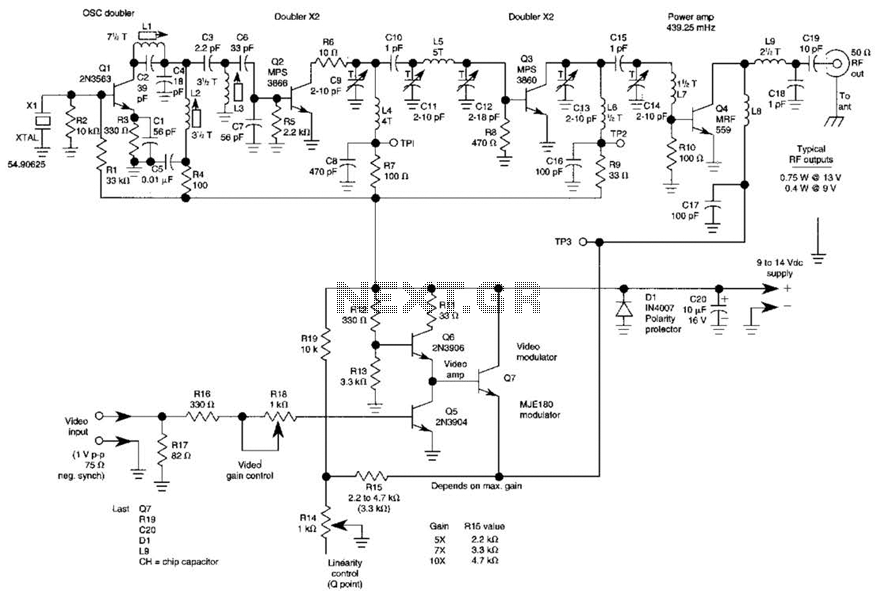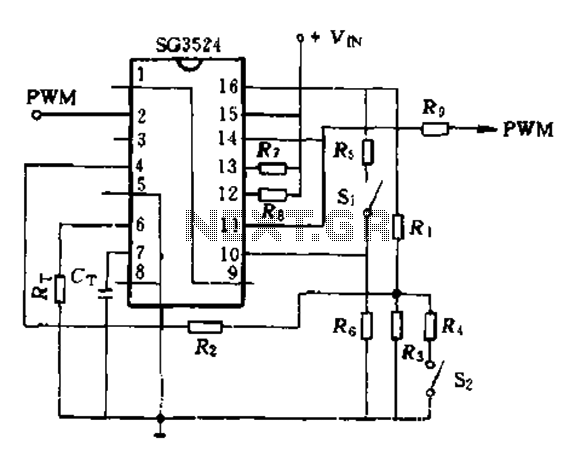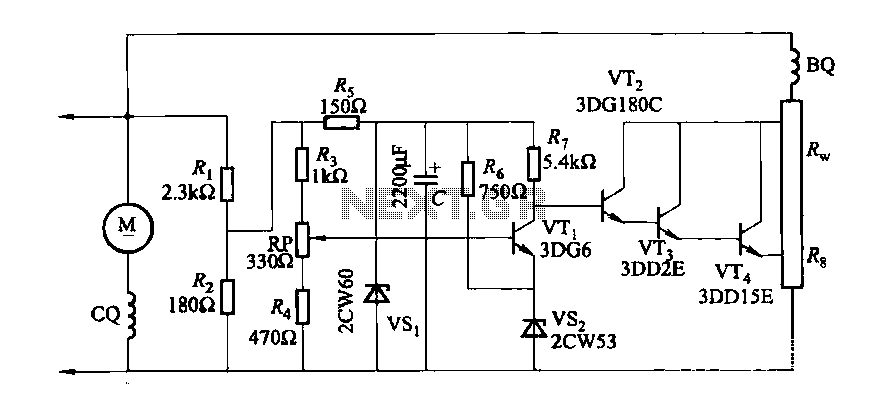
555 timer Mono stable (one shot) circuit circuit
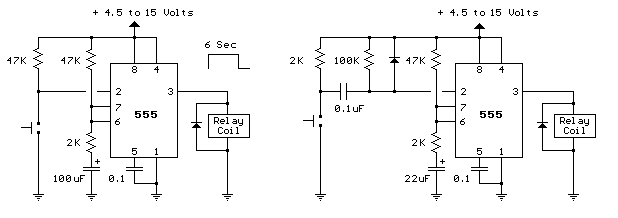
The two circuits demonstrate the use of a 555 timer to activate a relay for a specified duration when a momentary normally open (N/O) push button is pressed. The circuit on the left is designed for extended time periods, allowing the push button to be pressed and released before the timing cycle concludes. For shorter timing intervals, a capacitor can be implemented to decouple the switch, ensuring that only the initial closure of the switch is detected by the timer input. This configuration permits the switch to remain closed indefinitely without influencing the output.
The described circuits utilize the 555 timer in monostable mode, where the timer generates a single output pulse in response to a trigger input. In the first circuit, the push button serves as the trigger, initiating the timing cycle upon being pressed. The timing duration is determined by the resistor-capacitor (RC) network connected to the 555 timer. When the button is pressed, the capacitor begins charging through the resistor, and once the voltage across the capacitor reaches two-thirds of the supply voltage, the output of the timer switches from low to high, activating the relay.
In the second circuit, designed for shorter timing applications, the capacitor is connected in parallel with the push button. This arrangement allows the capacitor to charge quickly when the button is pressed, but it also isolates the timer from the continuous closure of the switch. As a result, the timer only registers the initial transition of the switch from open to closed, effectively ignoring any subsequent state changes while the switch remains closed. This feature is particularly useful in applications where the user might hold down the button for an extended period, as it prevents unintended relay activation beyond the desired timing duration.
Both circuits can be powered by a standard DC power supply compatible with the 555 timer's operating voltage range, typically between 4.5V and 15V. The relay used in conjunction with the timer can be selected based on the load requirements, ensuring it can handle the current and voltage specifications of the intended application. The output of the 555 timer can be connected directly to the relay's coil, with appropriate flyback diode protection to prevent voltage spikes from damaging the timer when the relay is de-energized.
Overall, these circuits provide flexible solutions for controlling relay operations based on user input, with the capability to adjust timing characteristics through the selection of resistor and capacitor values in the timing network.The two circuits illustrate using the 555 timer to close a relay for a predetermined amount of time by pressing a momentary N/O push button. The circuit on the left can be used for long time periods where the push button can be pressed and released before the end of the timing period.
For shorter periods, a capacitor can be used to isolate the switch so that only the initial switch closure is seen by the timer input and the switch can remain closed for an unlimited period without effecting the output.. 🔗 External reference
The described circuits utilize the 555 timer in monostable mode, where the timer generates a single output pulse in response to a trigger input. In the first circuit, the push button serves as the trigger, initiating the timing cycle upon being pressed. The timing duration is determined by the resistor-capacitor (RC) network connected to the 555 timer. When the button is pressed, the capacitor begins charging through the resistor, and once the voltage across the capacitor reaches two-thirds of the supply voltage, the output of the timer switches from low to high, activating the relay.
In the second circuit, designed for shorter timing applications, the capacitor is connected in parallel with the push button. This arrangement allows the capacitor to charge quickly when the button is pressed, but it also isolates the timer from the continuous closure of the switch. As a result, the timer only registers the initial transition of the switch from open to closed, effectively ignoring any subsequent state changes while the switch remains closed. This feature is particularly useful in applications where the user might hold down the button for an extended period, as it prevents unintended relay activation beyond the desired timing duration.
Both circuits can be powered by a standard DC power supply compatible with the 555 timer's operating voltage range, typically between 4.5V and 15V. The relay used in conjunction with the timer can be selected based on the load requirements, ensuring it can handle the current and voltage specifications of the intended application. The output of the 555 timer can be connected directly to the relay's coil, with appropriate flyback diode protection to prevent voltage spikes from damaging the timer when the relay is de-energized.
Overall, these circuits provide flexible solutions for controlling relay operations based on user input, with the capability to adjust timing characteristics through the selection of resistor and capacitor values in the timing network.The two circuits illustrate using the 555 timer to close a relay for a predetermined amount of time by pressing a momentary N/O push button. The circuit on the left can be used for long time periods where the push button can be pressed and released before the end of the timing period.
For shorter periods, a capacitor can be used to isolate the switch so that only the initial switch closure is seen by the timer input and the switch can remain closed for an unlimited period without effecting the output.. 🔗 External reference
Warning: include(partials/cookie-banner.php): Failed to open stream: Permission denied in /var/www/html/nextgr/view-circuit.php on line 713
Warning: include(): Failed opening 'partials/cookie-banner.php' for inclusion (include_path='.:/usr/share/php') in /var/www/html/nextgr/view-circuit.php on line 713
